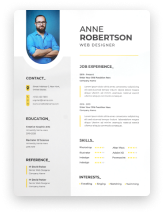Section 1: Understanding the Basics
Diving into the realm of resume writing, the education section demands careful attention and a strategic approach. Let's break down the basics to ensure you're on the right track.
1.1 What is the Education Section?: Unraveling Its Significance
The education section of your resume is more than just a list of schools and degrees. It's a space to showcase your academic journey, highlight your achievements, and prove that you have the necessary background for the job. Whether you have a PhD or just graduated high school, this section speaks volumes about your capabilities and potential.
1.2 Resume Formats and Education: Tailoring Your Approach
Different resume formats call for different approaches to listing education. Let's explore the three main types:
-
Chronological Resume Format: Here, you list your educational qualifications in reverse chronological order, starting with the most recent. It's straightforward and works well if your latest degree is relevant to the job.
-
Functional Resume Format: This format focuses on skills and qualifications, rather than chronological work history. Place your education near the top of your resume, and highlight any relevant coursework or academic achievements.
-
Combination Resume Format: As the name suggests, this format merges aspects of both chronological and functional resumes. You can showcase relevant skills while also highlighting your educational background in reverse chronological order.
1.3 Identifying Your Educational Background: What to Consider
When listing your education, think about what will be most relevant to the job. Consider the following aspects:
- Degrees obtained
- Schools attended
- Relevant coursework
- Academic honors and awards
- Extracurricular activities
Remember, the goal is to present your qualifications in a way that resonates with potential employers and shows that you're the right fit for the position.
Section 2: Preparing to List Your Education
Before you start crafting the education section of your resume, it's important to gather all necessary information and decide on the most relevant details to include. This preparation will ensure that you present your academic background in the best possible light.
2.1 Gathering the Necessary Information: What You Need
Here's a comprehensive checklist of the details you should collect:
- Institution Name: Make sure to use the full, official name of the educational institutions you attended.
- Degree Obtained: Clearly state the type of degree and the field of study. For example, "Bachelor of Science in Computer Science."
- Graduation Date: You can include the month and the year, or just the year if you prefer.
- Honors and Awards: If you graduated with honors or received any academic awards, this is the place to mention them.
- GPA: Including your GPA is optional, and generally recommended if it's above 3.5.
- Relevant Coursework: Listing courses relevant to the job can help showcase your knowledge.
- Extracurricular Activities: If you were involved in relevant clubs or organizations, don't hesitate to include them.
2.2 Making Decisions: What to Include and Exclude
Strategically deciding what to include in your education section can significantly impact your resume's effectiveness.
- Including High School: If you've completed a university degree, it's usually unnecessary to include your high school education. However, if high school is your highest level of education, you should definitely include it.
Example for Including High School:
Wilson High School
Portland, Oregon
Graduated: June 2016
Example for Listing Unfinished Degrees:
University of Oregon
Eugene, Oregon
- Completed 75 credits towards a Bachelor of Science in Biology
- Online Courses and Certifications: As the world of education evolves, online courses and certifications have become more prevalent and accepted. Make sure to include them, especially if they are relevant to the job.
Section 3: Crafting the Education Section
Now that you've gathered all the necessary information and decided what to include, it's time to start crafting the education section of your resume. The goal here is to present your academic background in a way that's clear, concise, and compelling.
3.1 Choosing the Right Format: Ensuring Clarity and Coherence
Choosing the right format is crucial for clarity and coherence. Here's how you can organize multiple degrees and position your education section:
- Multiple Degrees: List them in reverse-chronological order, with the most recent degree first.
Correct Example:
Master of Science in Environmental Science
XYZ University, 2022
Bachelor of Science in Biology
ABC University, 2018
Incorrect Example:
Bachelor of Science in Biology
ABC University, 2018
Master of Science in Environmental Science
XYZ University, 2022
- Positioning Education: If you're a recent graduate, place your education section near the top of your resume. If you have substantial work experience, it might make more sense to place it after your work experience section.
3.2 Using Action Words and Quantifiable Results: Bringing Life to Your Qualifications
Using action words and quantifiable results can help to bring life to your qualifications. Instead of just listing your degrees and awards, try to frame them in a way that shows your accomplishments.
Example for Using Action Words and Quantifiable Results:
- Graduated cum laude with a Bachelor of Arts in Communication, demonstrating strong research and analytical skills through a senior thesis project that received the department's top honors.
3.3 Highlighting Relevant Coursework and Skills: Making a Direct Connection
To make your resume stand out, highlight relevant coursework and skills that are directly related to the job.
- Relevant Coursework: List courses that are directly relevant to the position you're applying for.
Example for Highlighting Relevant Coursework:
-
Relevant Coursework:
- Data Analysis,
- Statistical Modeling,
- Survey Design
Skills: Highlight specific skills learned through your education that are applicable to the job.
Example for Highlighting Skills:
- Developed strong analytical skills through extensive coursework in data analysis and statistical modeling.
By carefully crafting the education section of your resume, you can demonstrate the full value of your academic background to potential employers.
Section 4: Examples and Templates
After crafting a comprehensive education section, it's time to look at various examples and templates to ensure you are on the right track. Examples can provide a clear picture of how to effectively present your educational background, catering to different circumstances and career stages.
4.1 Example for Recent Graduates: Showcasing Education
As a recent graduate, your education section plays a crucial role in your resume. It's important to highlight your academic achievements and relevant coursework to make up for the lack of extensive work experience.
Example for a Recent Graduate:
Bachelor of Arts in English Literature
XYZ University, 2023
- Cum Laude, GPA: 3.7/4.0
- Relevant Coursework:
- Literary Analysis,
- Creative Writing,
- Critical Thinking
- Honors:
- Dean's List (4 semesters),
- Winner of the University's Annual Short Story Competition
4.2 Example for Experienced Professionals: Where Education Fits In
For seasoned professionals, the education section complements the work experience section. It's important to be concise and focus on the most relevant academic achievements.
Example for an Experienced Professional:
Master of Business Administration
ABC School of Business, 2015
Bachelor of Science in Marketing
XYZ University, 2010
4.3 Example for Career Changers: Leveraging Your Education
If you are changing careers, your education can be a powerful tool to highlight transferable skills and relevant knowledge.
Example for a Career Changer:
Associate of Applied Science in Graphic Design
ABC Community College, 2020
Bachelor of Science in Business Administration
XYZ University, 2010
- Relevant Coursework:
- Visual Communication,
- Design Principles,
- Marketing 101
4.4 Example for Professionals with Advanced Degrees: Highlighting Advanced Education
Individuals with advanced degrees should focus on highlighting their highest level of education and any specialized training.
Example for a Professional with an Advanced Degree:
Ph.D. in Chemical Engineering
ABC Institute of Technology, 2018
Master of Science in Chemistry
XYZ University, 2014
Bachelor of Science in Chemistry
LMN College, 2010
4.5 Template: Crafting Your Education Section
Here's a template to help guide you in crafting your own education section:
- Degree Earned (e.g., Bachelor of Arts in English)
- Name of Institution, Graduation Date
- GPA (if above 3.0)
- Honors (e.g., Cum Laude, Dean's List)
- Relevant Coursework: [List a few key courses relevant to the job]
- Extracurricular Activities: [Include if relevant]
By utilizing these examples and templates, you can better understand how to tailor your education section to reflect your background, making a strong impression on potential employers.
Section 5: Common Mistakes and How to Avoid Them
Understanding the common pitfalls associated with listing education on your resume can significantly enhance the quality of your job application. In this section, we'll delve into these mistakes and provide strategies to avoid them.
5.1 Overloading with Information: Finding the Balance
One of the most prevalent mistakes is cluttering the education section with excessive details. While it's crucial to be thorough, it's equally important to be concise.
- Do: List relevant degrees, certifications, and coursework.
- Do Not: Include every course, seminar, or workshop you've ever attended.
Correct Example:
Bachelor of Science in Computer Science
XYZ University, 2020.
- Relevant Coursework:
- Data Structures,
- Algorithms,
- Machine Learning.
Incorrect Example:
Bachelor of Science in Computer Science
XYZ University, 2020.
- Courses taken:
- Data Structures,
- Algorithms,
- Machine Learning,
- Calculus I,
- Calculus II,
- Physics,
- World History,
- English Literature... [and 20 more courses].
5.2 Forgetting to Mention Relevant Coursework: Why It's Essential
Neglecting to mention relevant coursework is a common oversight, especially for recent graduates or those with less professional experience.
- Do: Include coursework that is directly related to the job you're applying for.
- Do Not: Assume employers will know what your degree entails.
Good Example for Including Relevant Coursework:
Bachelor of Arts in Communication
XYZ University, 2021
- Relevant Coursework:
- Media Writing,
- Digital Communication,
- Public Relations Strategies
5.3 Inconsistent Formatting: Maintaining a Professional Look
Inconsistent formatting can distract the reader and make your resume appear unprofessional.
- Do: Maintain a consistent format throughout your resume.
- Do Not: Use different fonts, sizes, or styles within the education section.
5.4 Typos and Grammatical Errors: The Importance of Proofreading
Even minor typos can leave a negative impression on potential employers.
- Do: Thoroughly proofread your resume, or ask a friend or professional to review it.
- Do Not: Rely solely on spell-check tools, as they might miss some errors or inconsistencies.
By being mindful of these common mistakes and following the provided guidelines, you can ensure that your education section effectively contributes to your overall resume, making a positive impact on potential employers.
Section 6: Tailoring Education to the Job Description
When you're applying for a job, it's crucial to tailor every section of your resume to the specific position, and the education section is no exception. Let's explore how to analyze job descriptions and highlight the most relevant educational qualifications.
6.1 Analyzing the Job Posting: What to Look For
Carefully reading the job description helps you understand what the employer is looking for in a candidate. Pay close attention to the qualifications and requirements listed.
- Do: Identify keywords and phrases related to education, degrees, and coursework.
- Do Not: Overlook any details, even if they seem minor.
6.2 Highlighting the Most Relevant Qualifications: Connecting the Dots
Once you've identified what the employer is looking for, it's time to showcase your most relevant educational qualifications.
- Do: Prioritize listing degrees, coursework, and academic achievements that directly align with the job requirements.
- Do Not: List every single educational detail if it's not pertinent to the position.
Example for Highlighting Relevant Qualifications:
Job Description:
Seeking a candidate with a background in computer science, well-versed in data structures and algorithms.
Resume Education Section:
Bachelor of Science in Computer Science
XYZ University, 2020
- Relevant Coursework:
- Data Structures,
- Algorithms,
- Machine Learning
6.3 Utilizing Keywords and Industry Terms: Speaking Their Language
Incorporating keywords and industry-specific terms from the job description into your resume can help you pass through Applicant Tracking Systems (ATS) and catch the employer's attention.
- Do: Use the exact terms and phrases used in the job description when listing your qualifications.
- Do Not: Ignore the terminology used by the employer.
By tailoring your education section to the job description, you increase your chances of making a strong impression and advancing to the next stage of the hiring process.
Section 7: The Do's and Don'ts of Listing Education
In the final leg of our comprehensive guide, we'll walk through the best practices (the do's) and common pitfalls (the don'ts) of listing education on your resume. It's all about striking the right balance and paying attention to the details.
7.1 The Do's: Best Practices
To ensure you present your educational background in the best possible light, adhere to these best practices:
- Be Honest and Transparent: Always provide accurate information about your educational achievements. False information can lead to job offers being rescinded.
- Use a Professional Tone: Your resume is a professional document, and the education section should reflect that with clear, concise language.
- List Your Most Recent Education First: If you have multiple degrees, list them in reverse-chronological order, with the most recent education first.
- Include Relevant Details: Alongside your degree and the name of the institution, include any honors, awards, or relevant coursework.
Correct Example:
Bachelor of Arts in English
Magna Cum Laude
XYZ University, 2018
7.2 The Don'ts: Common Pitfalls
Avoid these common pitfalls to ensure your education section supports, rather than detracts from, your overall resume:
- Avoiding Irrelevant Information: Do not list every course, achievement, or extracurricular activity unless it directly relates to the job.
- Not Overlooking Formatting: Maintain consistency in formatting throughout your resume, including the education section. Inconsistencies can be distracting and appear unprofessional.
- Forgetting to Proofread: Typos and grammatical errors in the education section are just as detrimental as they are in other sections of your resume.
Incorrect Example:
Bachelors in English
XYZ University, 2018
Graduated in the top 30%
By following these do's and don'ts, you can craft an education section that complements the rest of your resume and helps to present you as a well-rounded and compelling candidate.
Conclusion
Summarizing Key Takeaways: What to Remember
In this comprehensive guide, we've covered everything you need to know about listing education on your resume. Remember the importance of tailoring your resume to each job, using clear and professional language, and paying attention to the details. Your education section is an opportunity to showcase your qualifications and connect your academic background to your professional aspirations.
Encouraging Continuous Learning and Resume Updating: Staying Competitive
The world of work is ever-evolving, and continuous learning is key to staying competitive. Keep your education section up-to-date, and don't hesitate to add any new qualifications, certifications, or coursework that may strengthen your candidacy.
Inviting Feedback and Questions: Opening the Floor
We encourage you to seek feedback on your resume from mentors, colleagues, or professional resume writers. They can provide valuable insights and help you fine-tune each section of your resume, including the education section.
Absolutely, let's refine and complete the FAQ section for better clarity and completeness:
Recommended Reading







